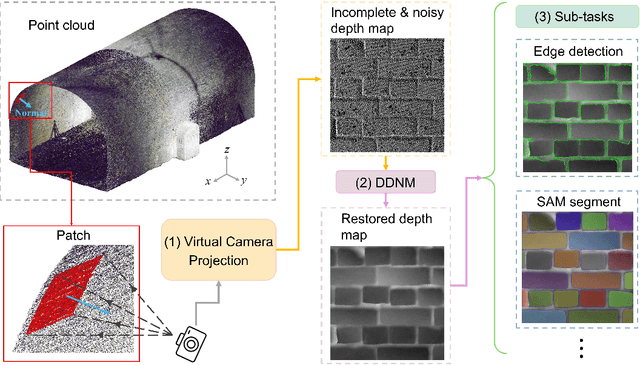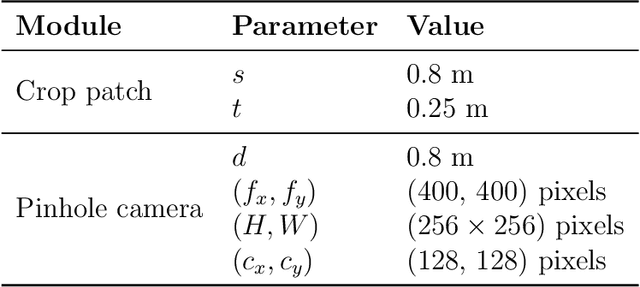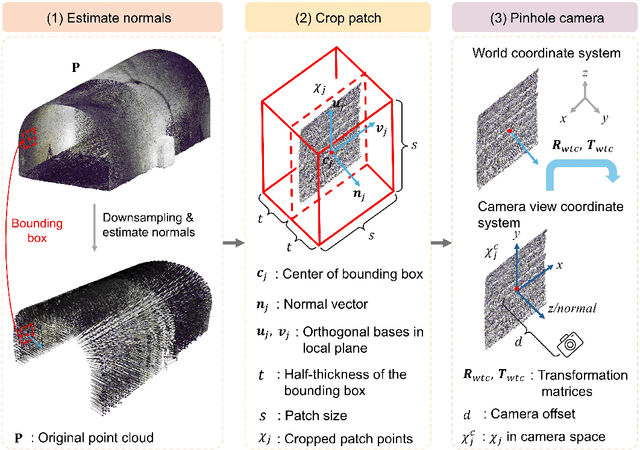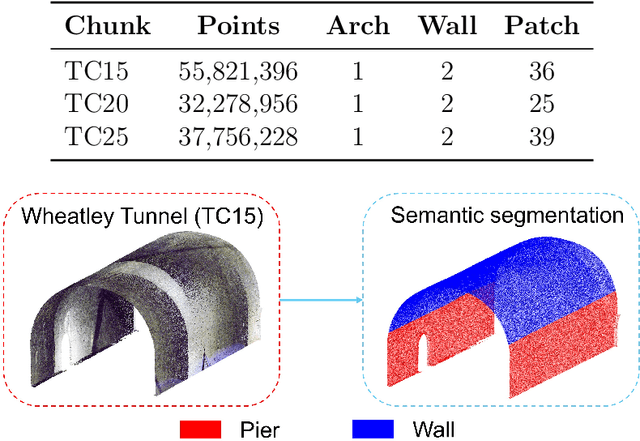Cheng Zhang
Uncertainty Matters in Dynamic Gaussian Splatting for Monocular 4D Reconstruction
Oct 14, 2025Abstract:Reconstructing dynamic 3D scenes from monocular input is fundamentally under-constrained, with ambiguities arising from occlusion and extreme novel views. While dynamic Gaussian Splatting offers an efficient representation, vanilla models optimize all Gaussian primitives uniformly, ignoring whether they are well or poorly observed. This limitation leads to motion drifts under occlusion and degraded synthesis when extrapolating to unseen views. We argue that uncertainty matters: Gaussians with recurring observations across views and time act as reliable anchors to guide motion, whereas those with limited visibility are treated as less reliable. To this end, we introduce USplat4D, a novel Uncertainty-aware dynamic Gaussian Splatting framework that propagates reliable motion cues to enhance 4D reconstruction. Our key insight is to estimate time-varying per-Gaussian uncertainty and leverages it to construct a spatio-temporal graph for uncertainty-aware optimization. Experiments on diverse real and synthetic datasets show that explicitly modeling uncertainty consistently improves dynamic Gaussian Splatting models, yielding more stable geometry under occlusion and high-quality synthesis at extreme viewpoints.
MiniBEE: A New Form Factor for Compact Bimanual Dexterity
Oct 02, 2025Abstract:Bimanual robot manipulators can achieve impressive dexterity, but typically rely on two full six- or seven- degree-of-freedom arms so that paired grippers can coordinate effectively. This traditional framework increases system complexity while only exploiting a fraction of the overall workspace for dexterous interaction. We introduce the MiniBEE (Miniature Bimanual End-effector), a compact system in which two reduced-mobility arms (3+ DOF each) are coupled into a kinematic chain that preserves full relative positioning between grippers. To guide our design, we formulate a kinematic dexterity metric that enlarges the dexterous workspace while keeping the mechanism lightweight and wearable. The resulting system supports two complementary modes: (i) wearable kinesthetic data collection with self-tracked gripper poses, and (ii) deployment on a standard robot arm, extending dexterity across its entire workspace. We present kinematic analysis and design optimization methods for maximizing dexterous range, and demonstrate an end-to-end pipeline in which wearable demonstrations train imitation learning policies that perform robust, real-world bimanual manipulation.
Incorporating Visual Cortical Lateral Connection Properties into CNN: Recurrent Activation and Excitatory-Inhibitory Separation
Sep 18, 2025Abstract:The original Convolutional Neural Networks (CNNs) and their modern updates such as the ResNet are heavily inspired by the mammalian visual system. These models include afferent connections (retina and LGN to the visual cortex) and long-range projections (connections across different visual cortical areas). However, in the mammalian visual system, there are connections within each visual cortical area, known as lateral (or horizontal) connections. These would roughly correspond to connections within CNN feature maps, and this important architectural feature is missing in current CNN models. In this paper, we present how such lateral connections can be modeled within the standard CNN framework, and test its benefits and analyze its emergent properties in relation to the biological visual system. We will focus on two main architectural features of lateral connections: (1) recurrent activation and (2) separation of excitatory and inhibitory connections. We show that recurrent CNN using weight sharing is equivalent to lateral connections, and propose a custom loss function to separate excitatory and inhibitory weights. The addition of these two leads to increased classification accuracy, and importantly, the activation properties and connection properties of the resulting model show properties similar to those observed in the biological visual system. We expect our approach to help align CNN closer to its biological counterpart and better understand the principles of visual cortical computation.
Compute as Teacher: Turning Inference Compute Into Reference-Free Supervision
Sep 17, 2025Abstract:Where do learning signals come from when there is no ground truth in post-training? We propose turning exploration into supervision through Compute as Teacher (CaT), which converts the model's own exploration at inference-time into reference-free supervision by synthesizing a single reference from a group of parallel rollouts and then optimizing toward it. Concretely, the current policy produces a group of rollouts; a frozen anchor (the initial policy) reconciles omissions and contradictions to estimate a reference, turning extra inference-time compute into a teacher signal. We turn this into rewards in two regimes: (i) verifiable tasks use programmatic equivalence on final answers; (ii) non-verifiable tasks use self-proposed rubrics-binary, auditable criteria scored by an independent LLM judge, with reward given by the fraction satisfied. Unlike selection methods (best-of-N, majority, perplexity, or judge scores), synthesis may disagree with the majority and be correct even when all rollouts are wrong; performance scales with the number of rollouts. As a test-time procedure, CaT improves Gemma 3 4B, Qwen 3 4B, and Llama 3.1 8B (up to +27% on MATH-500; +12% on HealthBench). With reinforcement learning (CaT-RL), we obtain further gains (up to +33% and +30%), with the trained policy surpassing the initial teacher signal.
InfraDiffusion: zero-shot depth map restoration with diffusion models and prompted segmentation from sparse infrastructure point clouds
Sep 03, 2025



Abstract:Point clouds are widely used for infrastructure monitoring by providing geometric information, where segmentation is required for downstream tasks such as defect detection. Existing research has automated semantic segmentation of structural components, while brick-level segmentation (identifying defects such as spalling and mortar loss) has been primarily conducted from RGB images. However, acquiring high-resolution images is impractical in low-light environments like masonry tunnels. Point clouds, though robust to dim lighting, are typically unstructured, sparse, and noisy, limiting fine-grained segmentation. We present InfraDiffusion, a zero-shot framework that projects masonry point clouds into depth maps using virtual cameras and restores them by adapting the Denoising Diffusion Null-space Model (DDNM). Without task-specific training, InfraDiffusion enhances visual clarity and geometric consistency of depth maps. Experiments on masonry bridge and tunnel point cloud datasets show significant improvements in brick-level segmentation using the Segment Anything Model (SAM), underscoring its potential for automated inspection of masonry assets. Our code and data is available at https://github.com/Jingyixiong/InfraDiffusion-official-implement.
Continuous Semi-Implicit Models
Jun 07, 2025Abstract:Semi-implicit distributions have shown great promise in variational inference and generative modeling. Hierarchical semi-implicit models, which stack multiple semi-implicit layers, enhance the expressiveness of semi-implicit distributions and can be used to accelerate diffusion models given pretrained score networks. However, their sequential training often suffers from slow convergence. In this paper, we introduce CoSIM, a continuous semi-implicit model that extends hierarchical semi-implicit models into a continuous framework. By incorporating a continuous transition kernel, CoSIM enables efficient, simulation-free training. Furthermore, we show that CoSIM achieves consistency with a carefully designed transition kernel, offering a novel approach for multistep distillation of generative models at the distributional level. Extensive experiments on image generation demonstrate that CoSIM performs on par or better than existing diffusion model acceleration methods, achieving superior performance on FD-DINOv2.
Sentinel: Scheduling Live Streams with Proactive Anomaly Detection in Crowdsourced Cloud-Edge Platforms
May 29, 2025Abstract:With the rapid growth of live streaming services, Crowdsourced Cloud-edge service Platforms (CCPs) are playing an increasingly important role in meeting the increasing demand. Although stream scheduling plays a critical role in optimizing CCPs' revenue, most optimization strategies struggle to achieve practical results due to various anomalies in unstable CCPs. Additionally, the substantial scale of CCPs magnifies the difficulties of anomaly detection in time-sensitive scheduling. To tackle these challenges, this paper proposes Sentinel, a proactive anomaly detection-based scheduling framework. Sentinel models the scheduling process as a two-stage Pre-Post-Scheduling paradigm: in the pre-scheduling stage, Sentinel conducts anomaly detection and constructs a strategy pool; in the post-scheduling stage, upon request arrival, it triggers an appropriate scheduling based on a pre-generated strategy to implement the scheduling process. Extensive experiments on realistic datasets show that Sentinel significantly reduces anomaly frequency by 70%, improves revenue by 74%, and doubles the scheduling speed.
COM Adjustment Mechanism Control for Multi-Configuration Motion Stability of Unmanned Deformable Vehicle
May 27, 2025Abstract:An unmanned deformable vehicle is a wheel-legged robot transforming between two configurations: vehicular and humanoid states, with different motion modes and stability characteristics. To address motion stability in multiple configurations, a center-of-mass adjustment mechanism was designed. Further, a motion stability hierarchical control algorithm was proposed, and an electromechanical model based on a two-degree-of-freedom center-of-mass adjustment mechanism was established. An unmanned-deformable-vehicle vehicular-state steady-state steering dynamics model and a gait planning kinematic model of humanoid state walking were established. A stability hierarchical control strategy was designed to realize the stability control. The results showed that the steady-state steering stability in vehicular state and the walking stability in humanoid state could be significantly improved by controlling the slider motion.
Get Experience from Practice: LLM Agents with Record & Replay
May 23, 2025Abstract:AI agents, empowered by Large Language Models (LLMs) and communication protocols such as MCP and A2A, have rapidly evolved from simple chatbots to autonomous entities capable of executing complex, multi-step tasks, demonstrating great potential. However, the LLMs' inherent uncertainty and heavy computational resource requirements pose four significant challenges to the development of safe and efficient agents: reliability, privacy, cost and performance. Existing approaches, like model alignment, workflow constraints and on-device model deployment, can partially alleviate some issues but often with limitations, failing to fundamentally resolve these challenges. This paper proposes a new paradigm called AgentRR (Agent Record & Replay), which introduces the classical record-and-replay mechanism into AI agent frameworks. The core idea is to: 1. Record an agent's interaction trace with its environment and internal decision process during task execution, 2. Summarize this trace into a structured "experience" encapsulating the workflow and constraints, and 3. Replay these experiences in subsequent similar tasks to guide the agent's behavior. We detail a multi-level experience abstraction method and a check function mechanism in AgentRR: the former balances experience specificity and generality, while the latter serves as a trust anchor to ensure completeness and safety during replay. In addition, we explore multiple application modes of AgentRR, including user-recorded task demonstration, large-small model collaboration and privacy-aware agent execution, and envision an experience repository for sharing and reusing knowledge to further reduce deployment cost.
Variational Autoencoding Discrete Diffusion with Enhanced Dimensional Correlations Modeling
May 23, 2025Abstract:Discrete diffusion models have recently shown great promise for modeling complex discrete data, with masked diffusion models (MDMs) offering a compelling trade-off between quality and generation speed. MDMs denoise by progressively unmasking multiple dimensions from an all-masked input, but their performance can degrade when using few denoising steps due to limited modeling of inter-dimensional dependencies. In this paper, we propose Variational Autoencoding Discrete Diffusion (VADD), a novel framework that enhances discrete diffusion with latent variable modeling to implicitly capture correlations among dimensions. By introducing an auxiliary recognition model, VADD enables stable training via variational lower bounds maximization and amortized inference over the training set. Our approach retains the efficiency of traditional MDMs while significantly improving sample quality, especially when the number of denoising steps is small. Empirical results on 2D toy data, pixel-level image generation, and text generation demonstrate that VADD consistently outperforms MDM baselines.
 Add to Chrome
Add to Chrome Add to Firefox
Add to Firefox Add to Edge
Add to Edge